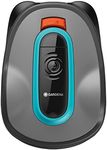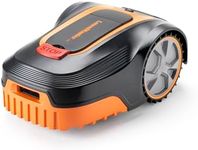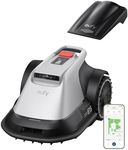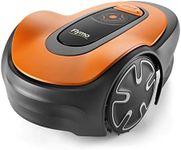Buying Guide for the Best Robotic Lawnmowers
Choosing the right robotic lawnmower can make maintaining your lawn a breeze. These devices are designed to autonomously cut your grass, saving you time and effort. When selecting a robotic lawnmower, consider the size and layout of your lawn, the type of grass you have, and any specific features you might need. Understanding the key specifications will help you find a model that suits your needs and ensures your lawn is kept in top condition.Cutting WidthThe cutting width refers to the width of the area that the mower can cut in a single pass. This is important because it affects how quickly the mower can cover your lawn. A wider cutting width means fewer passes are needed, which can be more efficient for larger lawns. Typically, cutting widths range from about 7 inches to 22 inches. For small to medium-sized lawns, a narrower cutting width may be sufficient, while larger lawns may benefit from a wider cutting width to reduce mowing time.
Battery LifeBattery life determines how long the robotic lawnmower can operate before needing a recharge. This is crucial for ensuring the mower can complete its task without frequent interruptions. Battery life can vary significantly, with some models offering 60 minutes of runtime and others up to 180 minutes or more. If you have a large lawn, a longer battery life is beneficial to cover more ground in one go. For smaller lawns, shorter battery life may be adequate, especially if the mower can recharge quickly.
Navigation SystemThe navigation system in a robotic lawnmower helps it move around your lawn efficiently and avoid obstacles. This can include boundary wires, sensors, or GPS systems. A sophisticated navigation system is important for complex lawns with many obstacles or irregular shapes. Basic models may use boundary wires to define the mowing area, while advanced models might use GPS for more precise navigation. Consider the complexity of your lawn when choosing a navigation system; simpler lawns may not require advanced navigation features.
Slope HandlingSlope handling refers to the mower's ability to operate on inclines. This is important if your lawn has hills or uneven terrain. Most robotic lawnmowers can handle slopes up to a certain degree, typically ranging from 15% to 45%. If your lawn is flat, slope handling may not be a concern. However, if you have a hilly lawn, look for models with higher slope handling capabilities to ensure effective mowing without getting stuck.
Cutting Height AdjustmentCutting height adjustment allows you to set the height at which the mower cuts the grass. This is important for maintaining the health and appearance of your lawn. Cutting heights can range from about 0.8 inches to 3.5 inches. If you prefer a neatly trimmed lawn, you might opt for a lower cutting height. Conversely, if you want to maintain a longer grass length for a lush look, choose a mower with higher cutting height options. Consider the type of grass and your aesthetic preferences when selecting cutting height adjustments.
Weather ResistanceWeather resistance indicates how well the mower can operate in various weather conditions, such as rain or extreme temperatures. This is important for ensuring the mower can function reliably throughout the mowing season. Some models are designed to work in wet conditions, while others may need to be sheltered during rain. If you live in an area with unpredictable weather, look for a model with good weather resistance to avoid interruptions in mowing. For areas with mild weather, this may be less of a concern.








